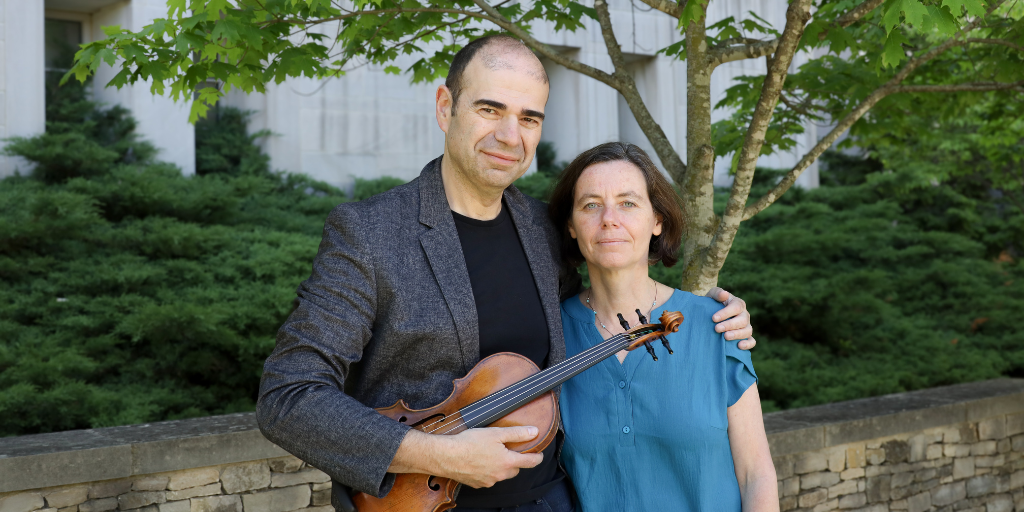Two fields converge in PBS neuroscientist Anna Kalinovsky’s unique course
In the lab of PBS neuroscientist Anna Kalinovsky, the focus is typically on the development of cerebellar folds and intricate neuronal networks choreographing motor behaviors, emotion, and cognition. On the other side of campus, her husband and collaborator, IU Jacobs School of Music violin professor Grigory Kalinovsky, is focused on his own choreography: guiding students through complex bowings, rhythmic patterns, and the fine art of not dropping a Stradivarius.
Together, they created a course that combines her work in neurodevelopmental biology with his decades of violin pedagogy, a class that’s equal parts Bach and brain scans, Haydn and Heschel’s gyrus, Prokofiev and primary auditory cortex.
A marriage of art and science
What does her field of neurodevelopmental biology have to do with music? You might be surprised by their commonalities. For one thing, as Anna explains, elements of music such as rhythm and the sense of timing are crucial for motor and cognitive abilities. “The internal feeling of rhythm and timing is essential for smooth, repetitive movements and also for higher-order cognitive processes like taking turns while speaking.” Deficits in the regulation of those behaviors result in conditions ranging from Parkinson’s Disease to Autism Spectrum Disorder. And in fact, music can serve as a kind of pacemaker for motor and emotional regulation for people with these conditions.
Moreover, watching Grigory’s detailed, step-by-step method of violin instruction, Anna recognized an uncanny resemblance to therapeutic interventions for children with neurodevelopmental disorders: “turning implicit into explicit learning and breaking a problem down into increasingly smaller steps.” Think of it as explaining how to walk, but with sheet music. As Anna puts it, music training can become a roadmap for understanding cognition.
An evolving venture
These realizations became the foundation of their interdisciplinary course, The Neural Basis of Music Perception. The course, now over a decade in the making, has evolved into a wide-ranging seminar exploring the neural bases of musical experiences and what they reveal about human cognition. Drawn to the class are a broad mix of psychology, neuroscience, and music majors. The format is that of a student-centered “flipped classroom” in which students lead discussions on current research in the neuroscience of music, culminating in a final project for which students imagine and propose their own fictitious study.
Students examine everything from why lullabies calm infants to how rhythm “entrains” the premotor cortex, what makes a song sound undeniably “Christmassy,” or what causes those pesky earworms and how to stop them… Discussions often merge musicology with neuroscience, drawing from both peer-reviewed studies and firsthand experience of the people in the classroom, as music consumers and performers.
A confluence of cultures
Grigory contributes the musical architecture: how phrasing, dynamics, and rhythm serve as tools to communicate emotion: “the modular nature of melodic and rhythmic structures employed in music.” He likens musical gestures to the work of a mime: intentional, structured, and capable of evoking a specific internal state. Musicians, he suggests, “like all artists, think deliberately about elements that evoke specific cognitive and emotional associations in listeners, as do scientists, who seek to understand how sensory inputs from our environment are interpreted as specific percepts.” Together, the two instructors challenge students to shift between scientific analysis and artistic intuition, a skill that proves surprisingly transferable.
As Grigory also notes, the students themselves, with their wide array of cultural backgrounds and musical tastes, bring much to the table: “It is always fascinating to discuss their ideas on what constitutes music, what they find enjoyable about listening to or playing music, and why we listen to music.”
Perhaps most importantly, the course provides students with a framework for recognizing their own cognitive biases, what Anna calls “our professional blind spots.” In conversation with each other and with their students, she and Grigory have created a model of interdisciplinary inquiry, one that invites science and art not just to coexist but to inform and enrich one another.

 The College of Arts
The College of Arts